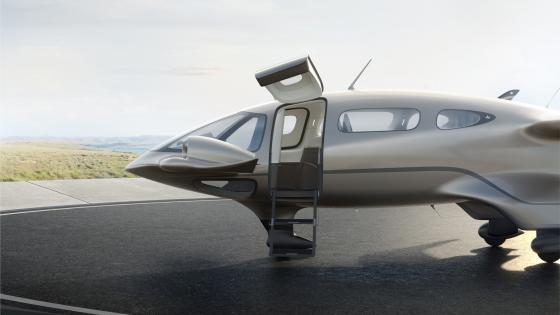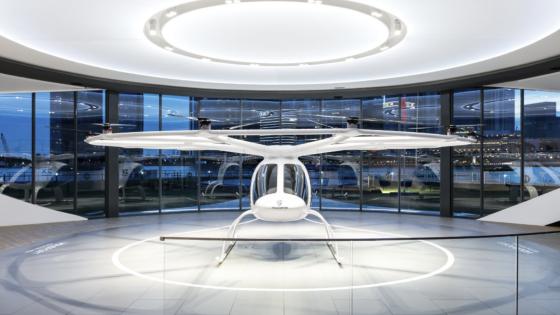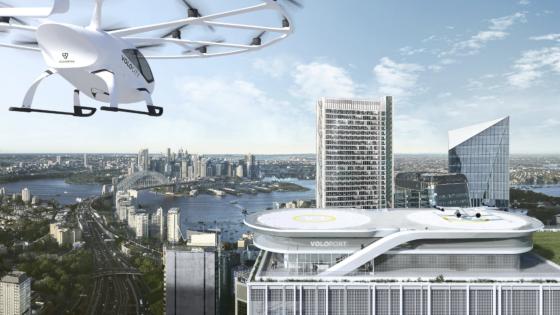From the AAM developer’s point of view, what is the most important element of vertiport design?
Paul-Franck Bijou, VP sales and business development at Lilium Air Mobility: It’s important to point out firstly that the Lilium Jet will not require dedicated vertiport infrastructure. We are building it to require minimal infrastructure enhancements beyond existing helipad design. At the most basic level, the Lilium Jet will only require an electrical charger to be installed to enable it to commence operations at an existing helipad. This is intentional, as we expect there to be limited dedicated Advanced Air Mobility (AAM) infrastructure at our EIS (entry-into-service). As the AAM market matures we expect to see more dedicated vertiport infrastructure being built to accommodate it.

Vertical Aerospace is conducting tethered flight tests with its VX4 eVTOL prototype at Kemble Airport in the UK
Andrew Macmillan, chief commercial and strategy officer, Vertical Aerospace: At its most basic, the most important element of a vertiport – assuming it meets the required safety regulations – will be its location. Vertiports need to be based where there is service demand. Vertiport operators like Skyports and Ferrovial, as well as existing infrastructure operators like airports and heliports, are already putting a lot of time and effort into determining the optimal location for this new infrastructure. In doing so, they will create meaningful networks of vertiports that work for consumers. Beyond location, keeping build costs down and operational efficiency, sufficient charging infrastructure and passenger experience will be important.
Joern Jaeger, head of airspace and vertiports, Volocopter: There are a few important elements to consider when designing vertiports. In a new and purpose-built infrastructure, a good vertiport design starts with a safe, efficient, and workable layout. In other words, form follows function. Additionally, depending on the target group of passengers, location, and capacity, all necessary elements for aircraft handling and passenger handling should be appropriately sized and positioned. It’s essential to consider the target group because the vertiport should be tailored to the needs of the passengers. For instance, business travellers with limited time have different needs to tourists looking fora unique flight experience. Lastly, a smart vertiport design should also allow flexibility that can incorporate temporary solutions and have the built-in capacity to be modified over time, to accommodate changing demand and new technical solutions in the aircraft and building domain. Examples include modular construction that allows for an increase or decrease in terminal size; a flexible layout to accommodate the manoeuvring of aircraft and charging infrastructure; and temporary vertiport operating solutions.

The Lilium Pioneer Edition Jet is designed to offer leading capacity, low noise, and high performance with zero operating emissions
Luiz Mauad, vice-president of services and operations, Eve Air Mobility: Current heliports can be adapted and equipped with charging stations to accommodate initial eVTOL operations. However, as the urban air mobility market grows, new infrastructure must be built to keep up with this development. At Eve, we believe vertiports should be organised as transport hubs, providing people with multiple travel options, such as trains, buses, bicycles, and scooters, to get them to and from their destinations. Furthermore, the Eve concept of a vertiport prioritises accessibility and sustainability, two key factors that separate it from traditional heliports.
What facilities would you expect/ want to see at a vertiport?
Macmillan: The key will be speed rather than expansive facilities. eVTOLs will be most appealing to passengers where they can move quickly and seamlessly from ground to air transport. Vertiports that facilitate this – minimising the time it takes for passengers to move through any ‘terminal’ – will have the advantage in most cases. This will include streamlined passenger processing, integrated ground transport links, digital real-time information and automated, slick operations. We should be thinking more of a subway stop than a major airport terminal.
Bijou: From a technical and regulatory perspective, the Lilium Jet will require a regulatory conforming take-off and landing area, centred within a FATO of 21x21m. The ground surface needs to be structurally loadbearing for a 3+ tonne aircraft on wheels and resilient to downwash from the Lilium Jet engines. The obstacle limitation surface for approach and departure flightpath should begin at ground level, to minimise the vertical aspect of the final landing procedure/ take off procedure
Essential infrastructure items include a 350kW off-the-shelf CCS electrical charger and, if ground taxiing was required to move the aircraft to a stand, a suitable towing vehicle.

Eve’s eVTOL is 100% electric and benefits from a human-centric design, the company says
Jaeger: Depending on the location and user group, vertiports will vary in capacity and appearance, but certain facility elements are necessary at all. For instance, airside, the vertiport must be able to facilitate aircraft handling, charging/fuelling and the means to provide rescue and firefighting services if required. There should also be a way to move the aircraft, and – not necessarily at every single airport, the means of storing and maintaining aircraft and parts. Landside, there should be facilities for handling passengers, including check-in and identification procedures. Size and capacity will depend on passenger throughput. Security measures and infrastructure, whether in terms of people and baggage, should be provided as necessary, while waiting areas and associated amenities are optional.
What would make you choose one vertiport operator over another?
Bijou: It will be the airline or operator that will choose the vertiport operator, but we believe local eVTOL demand, landing site location and landing fee will be determining factors.
Macmillan: This will ultimately be up to the operators of Vertical’s VX4 aircraft. I would anticipate the major factors will include cost of access, location, connectivity to other transport, operational efficiency and sustainability. Underlining all this will, of course, be their demonstrated ability to safely operate the vertiport.
Mauad: Eve won’t operate eVTOLs, our customers will. To date, we have letters of intent for up to 2,850 aircraft from airlines, helicopter operators, leasing companies and ride-share platforms. At Eve, we want to create safe, sustainable and accessible mobility experiences, so, during the past years, we’ve been working and engaging closely not only with customers but also with partners and all the UAM stakeholders to foster the industry and influence this approach from a global perspective.

The VoloPort is a joint development between Volocopter and Skyports
Jaeger: It is most important that a vertiport operator has a solid understanding of VTOL operations, smart vertiport designs, and the ability to identify attractive locations. Experience in traditional airport design and operations helps identify elements required by a vertiport but does not necessarily give a competitive edge to an incumbent airport operator. Smart vertiport design only exists with the understanding of the (e)VTOL aircraft performance capabilities and operational requirements. This again requires certain characteristics of a vertiport operator, not least knowledge of or willingness to learn about eVTOL operations, performance, and ground handling requirements. The operator must be willing to share commercial risks, and must have an understanding of the vertiport as a part of a network. A good operator will be prepared to contribute to solutions that benefit the overall UAM/AAM operations beyond their own vertiport perimeter, for instance by taking responsibility for diversion locations.
How do you feel about vertiports being designed to accommodate different types of AAM?
Macmillan: Our expectation is that most vertiports will be designed to be as agnostic to the aircraft type as possible. Regulators, including EASA and the FAA, have set out quite some detail on the standards vertiports should be designed to meet. These provide a strong basis for infrastructure providers, eVTOL manufacturers and even drone developers to ensure there is interoperability across different aircraft types.
Mauad: eVTOLs will not replace helicopters, which will still exist and operate their missions. Drones are also part of this market and will all share the lower airspace. That being said, Eve has been looking at the AAM industry holistically. We’re developing not only an eVTOL but also an urban air traffic management solution (Urban ATM) tailored specifically for vertiport and fleet operators, ANSPs and urban authorities, which will improve safety, optimise performance, maximise resource usage, and increase the volume of all operations in low-level airspace. We recently collaborated with Flexjet to advance UAM through an innovative simulation to validate and refine our Urban ATM software solution in real-case scenarios. We are currently reviewing the findings and discussing recommendations for improvements, changes, and potential integration requirements.

The Lilium Pioneer Edition Jet has been purpose-built for regional connectivity
Bijou: The Lilium Jet is not expected to require anything bespoke and we expect it to be operated to or from any landing infrastructure compliant with EASA vertiport and/or heliport requirements. We do not have any preference regarding utilisation of landing infrastructure, be it exclusive or shared with other OEMs.
Jaeger: The agnostic vertiport is good in principle. Accepting multiple types of AAM at one vertiport leads to better asset utilisation and the reduction of individual fees of air operating companies. On the other hand, urban vertiports will likely have a smaller footprint in comparison to airports or large vertiports. Passenger demand at these locations may quickly exceed capacity, and therefore, introducing multiple aircraft types might not justify the additional effort or investment in infrastructure.
Potential disadvantages for agnostic vertiports include the need for larger FATO and stand dimensions, meaning that more land is required, the need for multiple charging infrastructures or GSE types, and having to site the vertiports further from urban areas due to high noise signature.
Would you prefer something bespoke?
Jaeger: Market participants favour the ‘aircraft agnostic’ vertiport, but this does not exist unless a vertiport is oversized and overly costly to cater to everyone and everything. Moreover, most existing airports are not designed to accommodate all types of aircraft, but to accommodate what is needed at that location. From an OEM perspective, the larger the vertiport, the higher the chances of accommodating all VTOL aircraft, and the likelihood that your aircraft will be able to use that vertiport.
In an urban setting, the usability of a vertiport for VTOL aircraft will depend on three main factors: aircraft noise, take-off and landing performance, and manoeuvrability, along the approach and departure routes under nominal and off-nominal conditions. These factors, along with the potential for an air operator to offer a seamless and convenient service to the passenger, should be considered and will determine the variety of possible aircraft types and air operators using a vertiport.

Vertical is the first British aerospace company to manufacture a new aircraft in over 20 years: shown here, its VX4 prototype
What countries/ regions are you keenest to operate in, and why?
Bijou: We believe that the Lilium Jet will be in high demand in countries or regions that suffer from disconnected ground transportation and where it can make a great contribution to people’s movement and therefore quality of life. We also believe our aircraft will be popular in countries benefitting from environmental conditions that allow operators of the Lilium jet to maximise operational hours, and in countries with high availability of electric power based on renewable sources.
Mauad: As mentioned earlier, Eve won’t operate eVTOLs – our customers will. However, during the past years, we’ve been engaging not only with customers but also with partners and other UAM stakeholders to foster the industry. Regarding specific regions, we’ve been working with our customers on potential launch cities for eVTOL flights according to their strategies and presence. Recently, we announced a collaboration with Hunch Mobility to bring eVTOL flights to Bangalore. In June last year, we announced a partnership with United Airlines to bring eVTOL flights to San Francisco.
Macmillan: This is a decision for our customers. Vertical Aerospace is proud to have customers in almost all corners of the earth – from the UK and Europe to Asia Pacific and the Americas, covering cities such as London, Seoul, Osaka, Miami and São Paulo. There is huge demand across the world for AAM services, and vertiport developments are tracking closely with where our customers are based. The whole industry is working hard to get this new, sustainable form of transport in operation as quickly as possible.

The partners intend the VoloPort to provide ‘a viable public service for cities around the world’
Jaeger: Volocopter and other UAM operators are interested in implementing their services wherever they can add value to existing traffic systems on the ground. This is not limited to any country or region, as traffic congestion is a global issue. Initially, it may take some pioneer locations and stakeholders to initiate UAM, but others who might be hesitant will eventually follow. It is important to note that regions and competent authorities that are more open to this new mode of transport provide an advantage for starting operations. Strong influencing factors for a successful UAM ecosystem are local regulations, public acceptance, climate conditions, and market demand. Aircraft design and production are additional factors that influence the ecosystem on a grander level, but less locally relevant.
